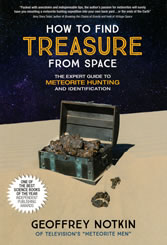Home » Meteorites » Meteorite Collecting
 Illustration by Timothy Arbon
Illustration by Timothy Arbon
HOW TO START A METEORITE COLLECTION
The tenth in a series of articles by Geoffrey Notkin, Aerolite Meteorites

Arizona stone meteorites: A collection of Arizona stone meteorites displayed in a glass cabinet to protect them from dust and accidental damage. The larger stones, above left, are an assortment of complete individuals, slices, and end cuts from the Gold Basin strewnfield (L4, Mohave County, Arizona). The original discovery was made in 1995 by Jim Kriegh, a retired University of Arizona professor out prospecting for gold. The small stones at right are Holbrooks (L/LL6 fell July 19, 1912). Note the small digital unit used to measure humidity inside the cabinet. Photograph by Leigh Anne DelRay, copyright Aerolite Meteorites. Click to enlarge.
In my day job as a meteorite dealer I have the pleasure of working with many first-time collectors. When discussing with a prospective customer what might make for a good "first meteorite," I frequently hear a budding enthusiast exclaim: "Wow, I never knew I could actually own a meteorite myself!"
| Dedicated to O. Richard Norton |
| This episode of Meteorwritings is respectfully dedicated to O. Richard Norton, a brilliant science writer and meteorite expert who passed away in May of 2009. Richard's trilogy of outstanding books: Rocks from Space, The Cambridge Encyclopedia of Meteorites, and The Field Guide to Meteors and Meteorites is a must for any enthusiast. Richard was also a long-standing member of the Meteorite magazine editorial board and a former director of Tucson's Flandrau Planetarium. He was a friend and colleague and will be greatly missed. |
Meteorite Collecting
Past and Present
Our understanding of meteoritics has changed greatly during the last two hundred years. As recently as the early 1800s few people believed that meteorites originated in outer space. I am paraphrasing here, but the official position of the Catholic Church ran something like this: God is perfect and God created the Heavens so the Heavens must also be perfect. If stones were to fall from the sky it would imply that all was not well in the Heavens, and such a belief would not be tolerated. Interestingly enough, this rather dogmatic viewpoint did not stop the Vatican from amassing one of the most impressive meteorite collections in history. I imagine the top clerics secretly admitted that something unusual might be going on up there.
In the spring of 1803 everything had to change after thousands of stone meteorites fell upon the fields of a French farming community named l'Aigle. Jean Baptiste Biot, a prominent French physicist investigated the fall, which had occurred in the middle of the day in front of many witnesses. Biot studied and described numerous black, fusion-crusted stones and accidentally became one of the world's first meteorite collectors. His beautifully labeled meteorite specimens can still be seen in prominent museum collections, and l'Aigle is a valuable and historic meteorite, much coveted by collectors.
In more recent times meteorites have become widely available, and relatively affordable, to the private collector. The rapid growth of the Internet has allowed collectors in our small field to meet, share information, and buy, sell and trade space rocks. Media attention in the form of newspaper and magazine stories about meteorite hunters, Hollywood movies such as Armageddon and Deep Impact, and numerous television documentaries have heightened public awareness of meteorites.
In addition, high profile natural history auctions in London, New York, Los Angeles and other cities often feature museum quality specimens and sometimes sky-high hammer prices too. Improved technology and a greater understanding of how meteorites fall has encouraged a new generation of meteorite hunters to go out and find their own space rocks. Meteorites were once the purview of major museums and a few wealthy collectors, but abundant affordable specimens from the Sahara Desert, Oman, and South America have made it possible to build a good collection without mortgaging the house.
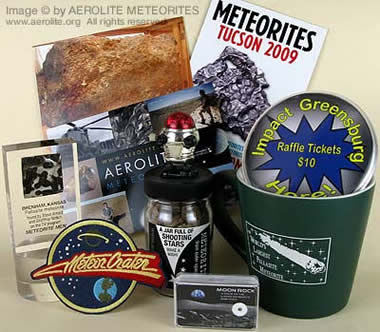
Meteorite-related collectibles: After a few years some meteorite collectors discover that acquiring new meteorites, alone, is not enough to feed the collecting bug. Pictured here is an assortment of meteorite-related collectibles including postcards and a small sample of lunar meteorite in display box. Of particular interest is the green coffee mug bearing the inscription "World's Largest Pallasite Meteorite." These mugs were once offered for sale in the Big Well Museum in Greensburg, Kansas which also prominently featured a 1,000-lb Brenham pallasite found by H.O. Stockwell in 1947. The mugs became obsolete (and highly collectible) after meteorite hunter Steve Arnold recovered a larger Brenham meteorite weighing 1,430 pounds in 2005. Photograph by Leigh Anne DelRay, copyright Aerolite Meteorites. Click to enlarge.
Building a Meteorite Collection
As readers of this column will already know, there are three main groups of meteorites: irons, stones, and stony-irons. Many beginning collectors start their love affair with space rocks by purchasing one representative example of each of these classes. As time goes by, the more experienced enthusiast often begins to specialize and may ultimately focus on one or two areas of collecting that hold a particular fascination.
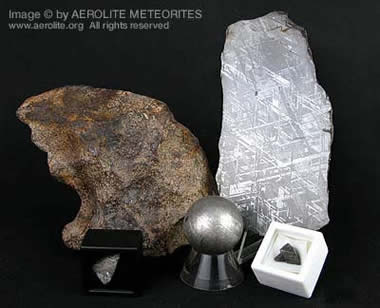
Gibeon iron meteorites: These examples of the Gibeon iron meteorite (IVA, Namibia, 1836) demonstrate the different directions a collection can take, based on only a single meteorite. Pictured clockwise from bottom left are a small cut, polished and etched part slice in a mineral box; a large complete individual with natural patina; a full slice etched to show the Widmanstatten Pattern; a small complete iron meteorite crystal in a mineral box; and an etched sphere. Photograph by Leigh Anne DelRay, copyright Aerolite Meteorites. Click to enlarge.
Collecting Meteorites:
A Type Collection
My great friend, the late Professor Jim Kriegh, was an accomplished meteorite hunter. He found many of the specimens in his fine collection himself, but he was also a type collector, and enjoyed nothing more than adding a rare sub-class to his display cabinet. A type collector is an enthusiast who hopes to acquire one or more illustrations of every class and sub-class of meteorite. It is a monumental undertaking, with about fifteen groups and subgroups for the irons alone, and about twenty for the relatively common stone chondrites. Other less abundant meteorites such as howardites and diogenites are expensive and difficult to obtain, while meteorites with a lunar or Martian origin can sometimes set the serious collector back $1,000 per gram or more.
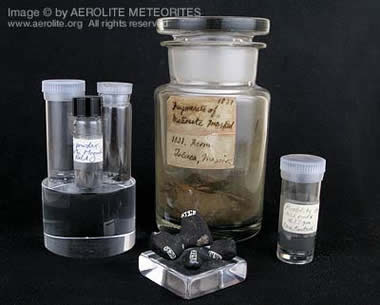
Jars of historic meteorites: Historic meteorites hold special interest for many collectors as they provide a tangible link to the past and also carry with them a solid provenance. The four small stones, bottom center, are Holbrook individuals with hand painted numbers from the American Museum of Natural History in New York City. The small jars were part of the late Dr. Elbert King's research collection. They contain dust and fragments from the Allende witnessed fall (CV3.2, fell February 8, 1969, Chihuahua, Mexico). Dr. King was a pioneering meteorite researcher and also designed NASA's Lunar Receiving Lab. The large glass container, center, is a vintage specimen jar from an unidentified collection, containing fragments of the Toluca meteorite (IAB, Mexico, found 1776). Photograph by Leigh Anne DelRay, copyright Aerolite Meteorites. Click to enlarge.
Collecting Meteorites:
Historic Specimens
A meteorite that is described as historic may be connected with an important past event such as the discovery of the first pallasite (Krasnojarsk, Siberia, 1749), or may once have been part of a well-known old collection. Meteorites that previously belonged to a prominent researcher or hunter are often of special interest, as are specimens accompanied by vintage identification labels or displaying hand painted collection numbers.
Some of the great meteorite collectors in history such as Harvey Nininger, Glenn Huss and Oscar Monnig developed their own cataloging system involving the painting of small numbers on each piece. In Nininger's system two sets of digits separated by a period identified both the actual meteorite and its position within his collection. For example, by referring to The Nininger Collection of Meteorites catalog published in 1950 I am able to determine that a 462-gram iron in my own collection bearing the number 34.3034 is a Canyon Diablo ("34") and was example number 3,034 of that meteorite in his inventory. Such a meteorite has a history attached to it, and would command a higher value on the collectors' market than a similar iron with no provenance.
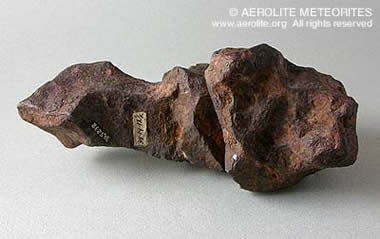
Canyon Diablo iron meteorite: An attractive example of the Canyon Diablo iron meteorite (IAB, Coconino County, Arizona, found 1891). Canyon Diablo specimens are associated with Arizona's famous Meteor Crater and this specimen comes from the celebrated Harvey H. Nininger American Meteorite Laboratory Collection. Painted on the specimen are the characteristic Nininger identification numbers, beginning with "34" which denotes Canyon Diablo. Near the middle of the iron is a second series of numbers, written on a gauze label, and glued to the specimen. The exact meaning of these numbers is unknown, but may be a code that Dr. Nininger devised to record the find location. Photograph by Geoffrey Notkin, copyright Aerolite Meteorites. Click to enlarge.
Collecting Meteorites:
Witnessed Falls
Some collectors specialize in witnessed falls-meteorites that were seen to fall to earth by credible observers. Witnessed falls are forever linked to a particular time and place such as the iron Sikhote-Alin (fell February 12, 1947 in Russia) or Peekskill (H6, fell October 9, 1992) a famous meteorite that partially demolished a parked car in upstate New York.
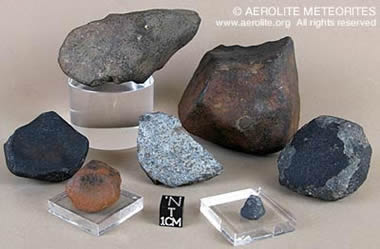
Collection of stone meteorites: An impressive collection of stone meteorites, comprising primarily witnessed falls. Clockwise from center: a polished end cut of Northwest Africa 869 (L4-6, Tindouf, Algeria, found 2000); a complete oriented Millbillillie individual (eucrite, fell October, 1960, Western Australia); a black fusion crusted example of Chergach (H5, fell July 2007, Erg Chech, Mali); on the lucite column is a complete individual of Gao-Guenie (H5 fell March 5, 1960, Burkina Faso); a large unclassified stone found in the Sahara Desert and designated NWA XXX; and two examples (one large, one small) of the Allende carbonaceous chondrite (CV3.2 fell February 8, 1969, Chihuahua, Mexico). The scale cube pictured is 1cm in size. Photograph by Leigh Anne DelRay, copyright Aerolite Meteorites. Click to enlarge.
Collecting Meteorites:
Aesthetic Shapes
|
The process of traveling through our atmosphere at high velocity causes meteorites to melt, sometimes forging them into fantastic and intriguing shapes. Iron meteorites are much more likely to acquire unusual surface characteristics, and those that have been altered by the elements into striking forms are often described as "aesthetic" or "sculptural" pieces. Particularly fine examples of sculptural irons have sold at top auction houses for many thousands of dollars and colorful descriptions in glossy catalogs have described them as "natural space sculptures."
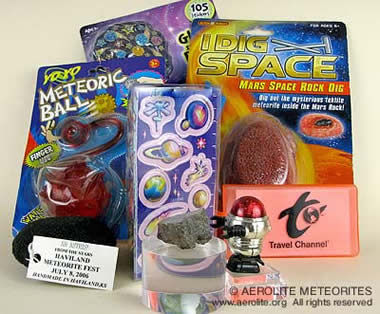
Meteorite toys and collectibles: Various meteorite toys and collectibles including (on lucite column) one of the Harvey Awards presented each year during the Tucson gem show for outstanding contributions to the field of meteorite collecting. The orange luggage tag is a memento from filming the "Meteorites" episode of The Best Places to Find Cash & Treasures for the Travel Channel. Photograph by Leigh Anne DelRay, copyright Aerolite Meteorites. Click to enlarge.
Collecting Meteorites:
Individuals and Fragments
A whole meteorite that has made the journey to earth without disintegrating is described as a complete individual. This term can apply to irons, stones and stony-irons. If a meteoroid breaks up into pieces-either in flight on upon impact-the resulting parts are described as fragments. The Sikhote-Alin meteorite fall produced both individuals and shrapnel-twisted angular fragments that are a result of explosions during flight. Complete individuals are usually more desirable to collectors, but broken fragments often show both the interior and exterior of a meteorite.
Collecting Meteorites:
Slices and End Cuts
Attractive whole individuals and sculptural irons are usually left intact, but some meteorites are cut and polished to display their interiors. Cutting is often necessary in order for academia to properly study a new find, and cutting can also reveal remarkable hidden beauty, such as in the crystal-studded pallasites. Slices are also often more affordable for the collector. A good quality 500-gram complete individual of Gao-Guenie (H5, fell March 5, 1960 in Burkina Faso) might fetch $750 to $1,000 on the retail market, while a 40-gram slice might sell for $80 to $100. So, purchasing slices or partial slices can be a good way to build up an inexpensive meteorite collection comprising many different types. When prepared in a laboratory a typical meteorite will usually produce a number of thin slices (sections) and two larger end cuts-a specimen displaying both the interior and exterior, much like the last part of a loaf of bread.
Collecting Meteorites:
Find Your Own
I was lucky enough to find my own first meteorite, on a rockhounding expedition back in the early 1990s. Since then I have traveled the world hunting for more, but continue to buy, sell, and trade as well. For the dedicated space rock enthusiast there is nothing more exciting than finding a real meteorite. But meteorite hunting is hard work, requires time, dedication, stamina, research, and good equipment. Please see our feature here on Geology.com "Meteorite Hunting: The Search for Space Rocks" to learn more.
Buying Meteorites: Authenticity
Beginning collectors are often concerned about authenticity, and buying from a reputable source is the best way to ensure you are spending money on the real thing. There are a number of full-time meteorite dealers who have been in business for many years and maintain an excellent reputation in the collecting community. Most have websites that feature their current inventory. There are also more than a few frauds out there, so do your research. Knowledge is an important tool for the meteorite collector. The experienced enthusiast will usually be able to recognize an authentic meteorite from a quick visual inspection, or even from a photograph. Our "Introductory Guide to Meteorite Identification" describes how to tell a meteorite from a meteor-wrong.
| Meteorwritings Menu |
Meteorites on eBay
Many collectors enjoy buying and selling specimens on eBay. Unfortunately, eBay does not invest much time in monitoring the authenticity of specimens on offer. While a number of reputable dealers and collectors regularly put up legitimate pieces for sale, every time I look through the eBay listings I find numerous lots that have been inaccurately described, or are not meteorites at all. While you may pick up a bargain on eBay, the serious collector prefers to work with established dealers who will stand behind the quality of pieces they sell.
The International Meteorite
Collectors Association (IMCA)
The IMCA is an international organization of meteorite enthusiasts dedicated to promoting the hobby, and ensuring the highest ethical standards among its members. The rotating IMCA Board is made up of accomplished meteorite collectors and researchers from around the world. People wishing to join must provide referrals from existing members, and must agree to abide by the IMCA's code of conduct. Members pay a modest annual membership fee, are assigned a unique number, and often display the IMCA logo on their websites. Buying from an official IMCA member is one of the best ways to ensure you are purchasing the genuine article.
Learning More About Meteorite Collecting
I recommend Kevin Kichinka's The Art of Collecting Meteorites. An enjoyable and informative introduction to the world of meteorite collecting, Kevin's book is packed with excellent color photos and helpful information, and is a joy to read. Philip M. Bagnall's The Meteorite & Tektite Collector's Handbook is also a useful resource, but is unfortunately out-of-print and difficult to acquire.
There has never been a better time to start a meteorite collection. There are more meteorites available on the market today than at any other time in history. Meteorite hunters continue to discover new material, and a network of international dealers offer meteorite specimens to suit all budgets. I encourage you to do a web search using the term "meteorites for sale" and see what's out there. But be careful! Once you have been bitten by the meteorite-collecting bug, it may never let go.
Geoff Notkin's Meteorite Book
|
About the Author
|
Geoffrey Notkin is a meteorite hunter, science writer, photographer, and musician. He was born in New York City, raised in London, England, and now makes his home in the Sonoran Desert in Arizona. A frequent contributor to science and art magazines, his work has appeared in Reader's Digest, The Village Voice, Wired, Meteorite, Seed, Sky & Telescope, Rock & Gem, Lapidary Journal, Geotimes, New York Press, and numerous other national and international publications. He works regularly in television and has made documentaries for The Discovery Channel, BBC, PBS, History Channel, National Geographic, A&E, and the Travel Channel.
Aerolite Meteorites - WE DIG SPACE ROCKS™
| More Meteorites |
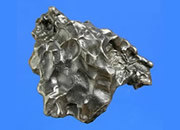 |
What Are Meteorites? |
 |
Extraterrestrial Gems |
 |
Gifts That Rock |
 |
Collecting Meteorites |
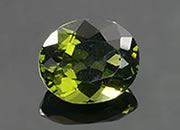 |
Moldavite |
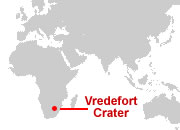 |
The Vredefort Crater |
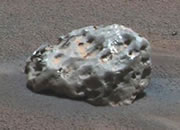 |
Mars Meteorites |
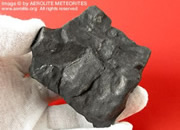 |
Meteorite Identification |

Find Other Topics on Geology.com:

|

| ||

|

| ||

|

| ||

|

|


